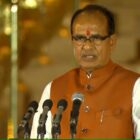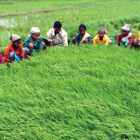India is failing on the nutritional self-sufficiency score and policy-makers should correct strategy stance, empowering the farmer to produce for nutritional adequacy.
Imagine, while constructing a multi-storey building the contractors discover the building foundation has begun to sink. It is scary, but wait. Now, imagine that even though the contractors know this, they simply decide to continue work rather than alter the plans. That is precisely the state of Indian agriculture today.
Overflowing granaries give us the smug satisfaction of having solved the food security problem. What we are experiencing is actually a temporary cereal surplus phase. It appears so only because India’s per capita consumption of protein, meat, poultry, fruit and vegetables is amongst the lowest in the world, limited by the still appallingly low purchasing capacity of the majority. When India eventually reverses the deceleration in growth, as it will someday, the demand for such produce will double. This may well happen in under a decade.
Climate change will further complicate efforts to salvage the future as inconsistent production gives recurring shocks. Today more than 50 per cent of the Indian population is being given free monthly rations. If this was extended by a year, even the illusion of a cereal surplus state would shatter like a sheet of glass. In the business as usual, farmers will need to be supported in perpetuity; they can never become atmanirbhar.
The question is how best to support farmers such that India may become nutrition self-reliant. Policymakers still talk of “food security” that was achieved decades ago. It is time to plan for “nutritional self-reliance”. These objectives require diametrically different strategies. To that end, India would do well to initiate what an eight-step approach to pre-empt the floor from slipping underneath our feet.
- First, forecast nutrition needs by the year 2050. By then, the population and the economy would have stabilised. Second, draw area production plans for animal husbandry and to grow crops to try and meet India’s nutritional requirement, considering agro-ecological zones and the changing climate. The aim should be to figure out a suitable basket of crops for each area.
- Third, based on these area production plans, incentivise only the identified crops and practices in each region, designing a risk and price support strategy for such crops, while allowing farmers the freedom to grow what they want.
- Fourth, the present farm input (fertiliser, power and such others) subsidy regime that incentivises production will need to shift to one of payment for farm ecosystem services (for environmentally sustainable agriculture practices like improving soil health, rainwater harvesting, intercropping, planting trees).
- Fifth, rather than constantly bickering with farmer unions about costs of crop cultivation, the government must reorient its thinking to calculating the real cost of growing food, moving away from the strategy of sacrificing farmers’ interests for the sake of cheap food for consumers.
- Sixth, investment in a robust market intelligence system can help the government manage production and price spikes. It has to be independent of the ministry of agriculture, which must, more importantly, issue regular crop advisories to farmers.
- Seventh, it is time to prioritise human capital over infrastructure by doubling existing agriculture R&D expenditure and filling all vacancies. In addition to revamping research and extension systems, more so to meet the expectations of traceability and quality produce, implement stringent enforcement of regulations, collaboration with the private sector and extensive use of digital technologies.
- Eighth, begin a 20-year awareness campaign across India to instill healthier eating habits. As for unhealthy food; tax it and disallow advertisements. Emulating western processed food habits will translate into higher healthcare costs. It is said that the cost of diabetes medication in the USA outstrips its expenditure on oil.
All policies create winners and losers and it is the government’s responsibility to ensure the losers are adequately compensated to their satisfaction. The establishment believes solutions are known and, in private, tosses the blame to politicians for not having the will to take politically contentious decisions. This is only partly true. Let aside the inability to arrive at solutions, they do not even recognise the problems clearly because they are complex to begin with and made worse by the interplay of climate change, environment, biodiversity, livestock, health and the role of big agriculture. The picture is too convoluted to grasp.
It is important to understand the problem and attempt solutions even if they fail because it is important to independently document failure, learn lessons and move forward with an adjusted policy framework. Failing this, in all probability, India will be providing subsidised food to the masses and continuing with an MGNREGA job-work programme to mitigate rural poverty well into the distant future.




